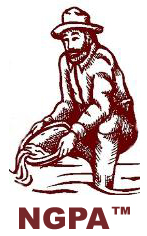Finding Roadside Gold in Alaska

It had been a dry, hot summer in the Alaska interior. Many of the creeks I’d prospected up were now dry. Most of the old timers here on Hog’em Gulch said they hadn’t seen it this dry in years. The only creek running in a steady wide stream was Hog’em.
The big miners on one of the side streams had saved a large pond of water from spring to sluice with during the summer. The chocolaty looking water was recycled again and again and run through the large sluicing plant until it became thick with mud and silt.
The EPA paid a visit to the big miners one afternoon and smiled the whole time they looked over the large commercial operation. What could they say–it was totally recycled water, no discharge, no creek to discharge into, and no water to replenish.

Suction dredge operator Chris Kriendler, up Hog’em about a mile, had built a six-foot deep pond. The creek lacked depth, and a small school of grayling had made their home in his pond because the creek was too shallow for them to swim any distance.
Chris welcomed the fish. Fortunately for the fish they were safe, because Chris was not a fish eater. Chris said the fish were real characters and very funny to watch. He kept them fed by digging at the edge of the creek side and knocking out bugs and worms now and then for them to eat.
Chris’s wife Trish used a highbanker nearby, working some bedrock away from Hog’em.
The bedrock off the creeks, or where the water had receded, leaving the bedrock dry, was ripe for a MACK-VACK. Although the vacuum unit can be used in water also, it does an excellent job on the dry bedrock.
I was driving my pickup up and down the creek, and up a few side gulches looking for a good place to run the Vack. I saw Trish and she pointed out a spot along the road where someone had started to break up bedrock and got some good color.
I drove my dust-covered truck through the shallow remnants of Hog’em Gulch to the other side, where a bumpy dirt road went up the waterless creek where the big miners were running off of the recycled water.
Along this road, about fifty feet from Hog’em, I found the bedrock Trish told me about near the edge of the road. What a convenient spot, I thought to myself. I parked the truck nearby on top of the bedrock I was about to work.
I fixed myself a bologna sandwich, sipped a Seven-up, and sprayed a little bug dope on.
After working bedrock for many years I’ve learned to do it in comfort, complete with soft pads to either kneel or sit on. Pads will save your bones–believe me!
The bedrock I was about to work was set up very well. All I had to do was set up my pad and sit down with my feet in a hole.
Using a small wrecking bar and large knife, I pried apart the large bedrock slabs, which were granite. Layers of clay and sand could be found packed in cracks and crevices. After I piled up dirt and removed larger rocks off to the side, I started up the VACK and with ease sucked up all and any loose particles of dust or dirt. The narrow hose attachment was great to get into the corners with, and for general cleanup.
If I wanted to move larger piles faster I took off the attachment. I could set the throttle on automatic or run it manually, speeding up the motor for a more powerful suction.
I ran the Vack until the bucket was nearly half full. There are several ways to produce with this valuable prospecting tool. If you have a hand sluice, high banker, or any type of water-operated gold separator that the contents of the bucket can be poured into, this will greatly speed up your gold production. But if you’re just testing, its easy to pan out the contents.
The Vack sucked up even the very fine dirt from the bedrock and after working most of the afternoon, it was cleaning up gold so well I estimated I was working on an average of a quarter-ounce of gold per yard of dirt. Most of the large commercial operations couldn’t even come near that ratio. They were recovering about an ounce to two ounces of gold per hundred yards.
I tested out about six half-bucketfuls, and recovered just over a pennyweight in small nuggets and fines. With each pan, I was able to determine fairly accurately in which direction throughout the bedrock the paystreak ran. Towards the road, I determined the paystreak held less gold. Working the bedrock towards the bank, the gold recovered was also less, but heading down toward the creek the gold recovered by the Vack was very consistent.
The Vack was stingy on gas and hardly used any. Its suction picked up a number of large rocks, though I tried to keep away from the large rocks.
After cleaning out a bedrock area, just to see how well it did, I went back through and vacuumed for any dust and found no stragglers. It was a perfect cleanup tool.
One of the big miners up the creek came down and watched and was amazed. He was even thinking how great it would be for cleaning up fines from his large sluice.
I sat on the edge of the bedrock after emptying the bucket into my large gold pan. I shook my head and smiled and thought, what a neat, thorough way to mine for gold.
I knew I had cleaned this bedrock up well and wouldn’t have to come back to this spot again!

